#Baron La Croix
Explore tagged Tumblr posts
Text
Some Pictures I Took From Fet Gede.
I enjoyed this years Fet Gede. This Sosyete not only celebrates the spirits here in the city. But respects and honors others Day of the Dead traditions also.
Fet Gede in Haiti is just such a past-honoring event. Known as the Festival of the Ancestors, Fet Gede ( = The Sacred Dead) is the Vodou equivalent of Mardi Gras, the Mexican Day of the Dead, and Halloween, all in one. So everyone dresses up.
But here are some pics I took while I was there. Check back for the video.

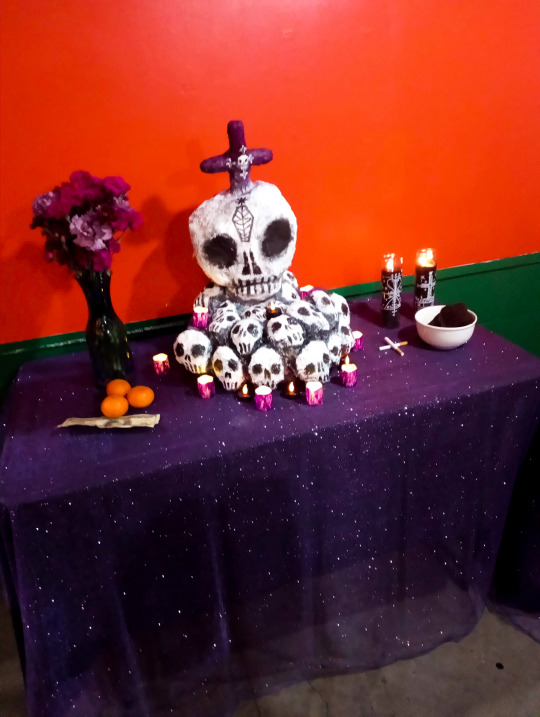
Spirit Statue. Gede Statue
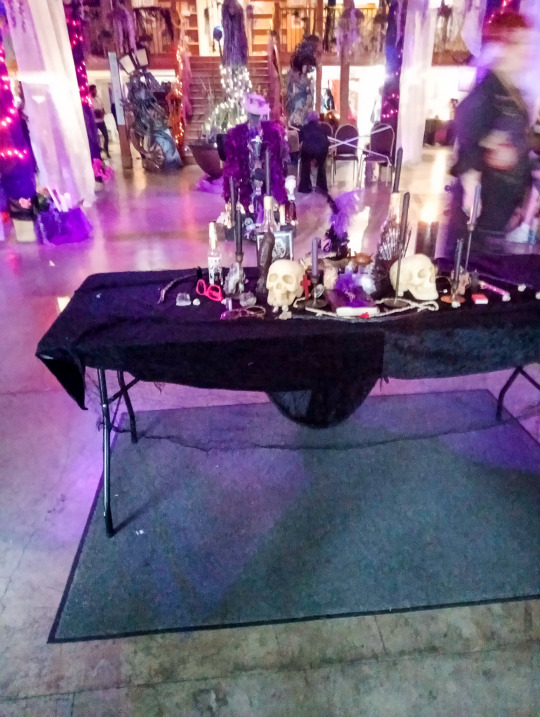
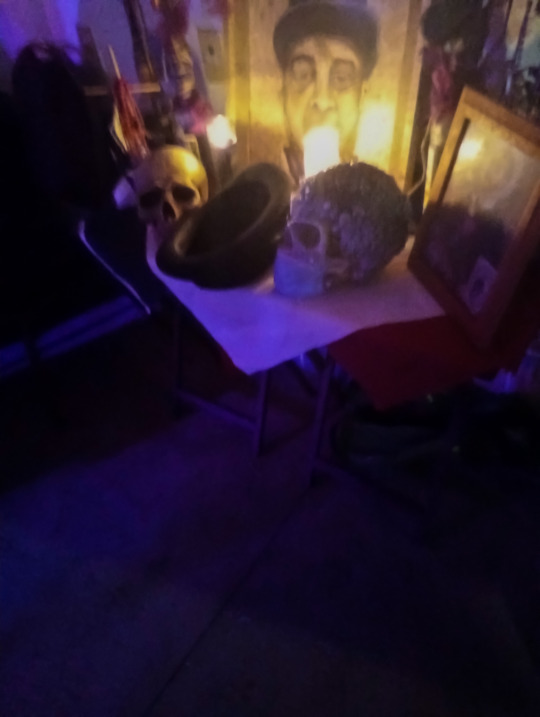
Baron Altar. Baron La Croix

Some kind of death mermaid statue.
It's cool.

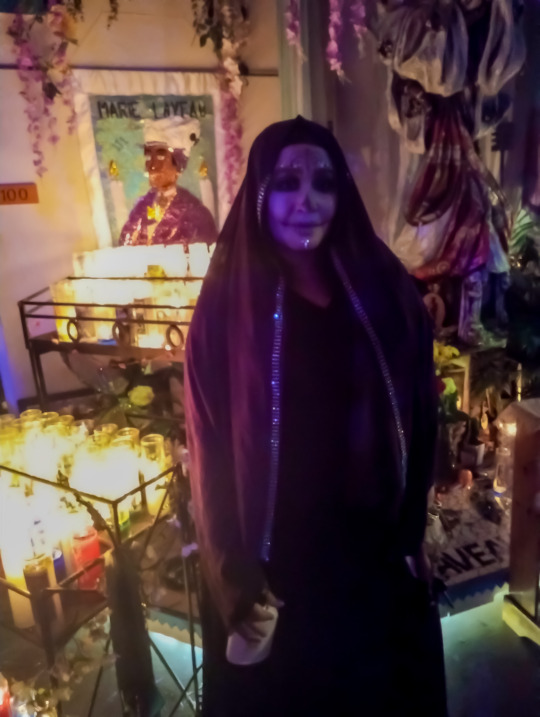
One of the children of the spirits dancers in the Oufo. Dressed as a spirit of the Dead. Gede.
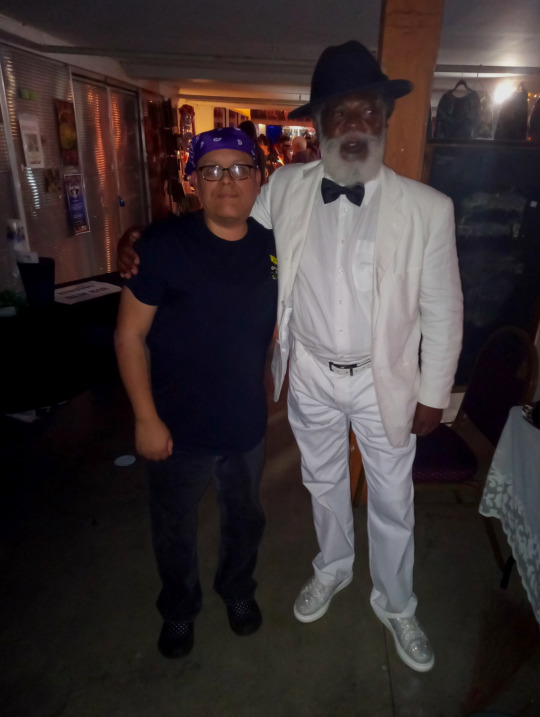
🖕Me and Ghanaian Priest & Master Drummer Osofo Andrew.
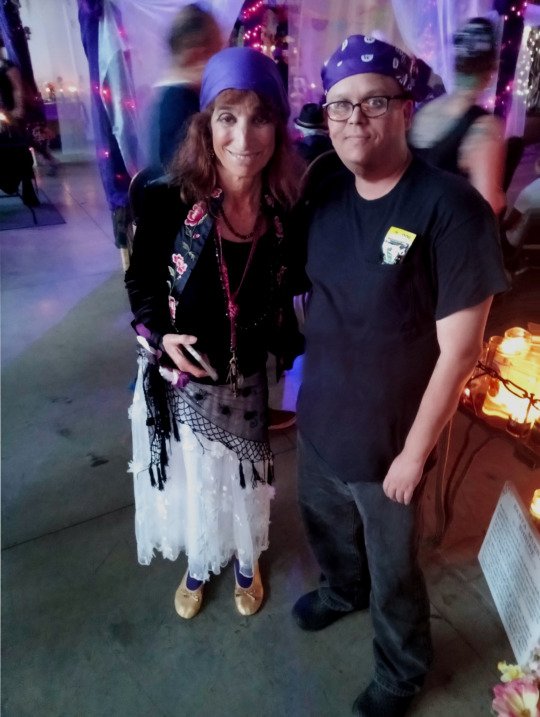
🖕 Me & Mambo Sally.

Taja Nicholle is a Afro-Indigenous Certified Death Doula/Grief Support Counselor. She's does death healing, cleansings readings, Sound Healing, etc.
https://www.therisingroseco.com/

I meet these women and though there costumes were cool.


🖕 the top is of a Haitian Oungan he and Andrew and some others released the Gede spirits after the Fet Gede was over. We told them thank you and then we all sayed a prayer.
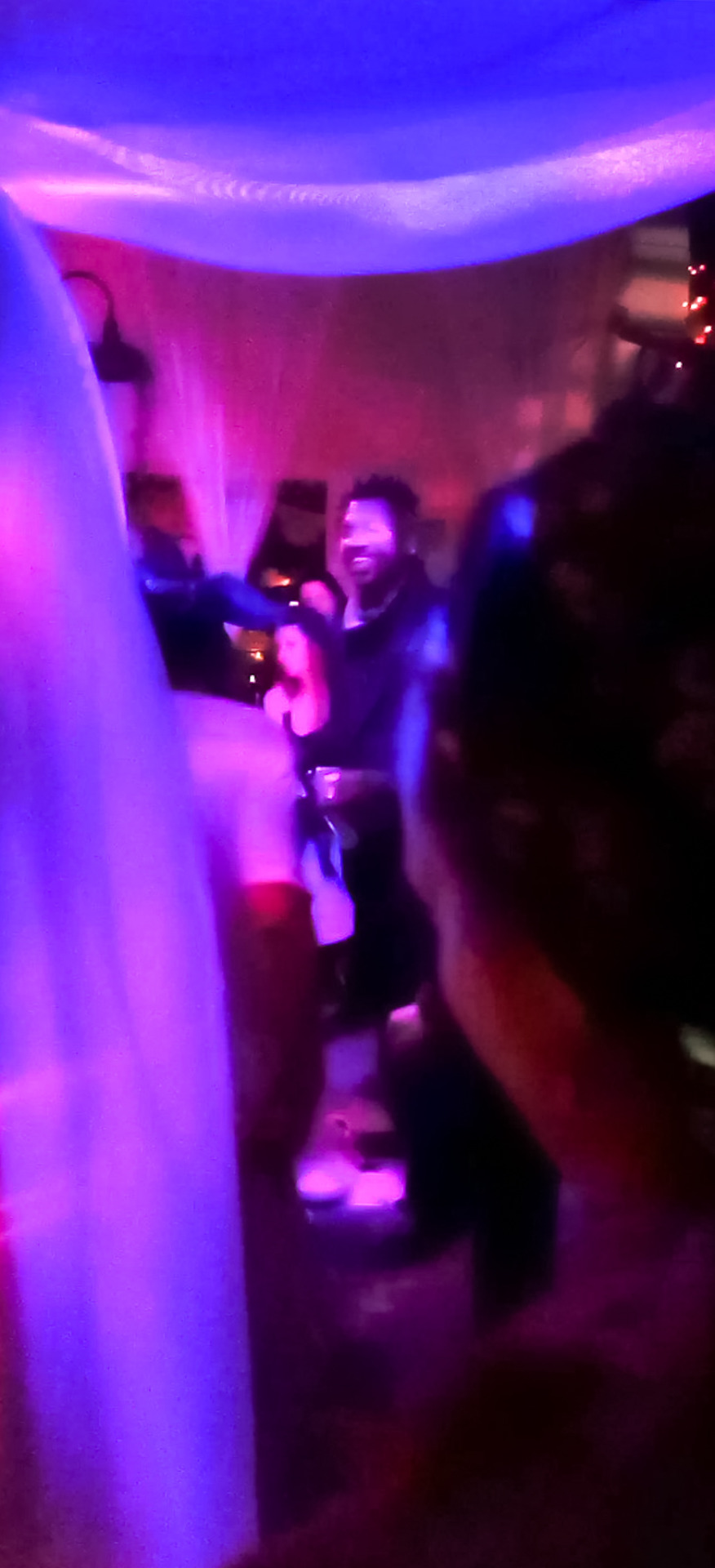
This is the Haitian Oungan with the white powder on his face he was dancing and smoking cigarettes the spirits came and jumped a few people that night.
#like and/or reblog!#google search#follow my blog#ask me anything#haitian vodou priest#haitian vodou#Fet Gede#voodoo priestess#Voodoo altar#dia de muertos#catrina#Baron La Croix#new orleans voodoo#Blessing.#new post
8 notes
·
View notes
Text
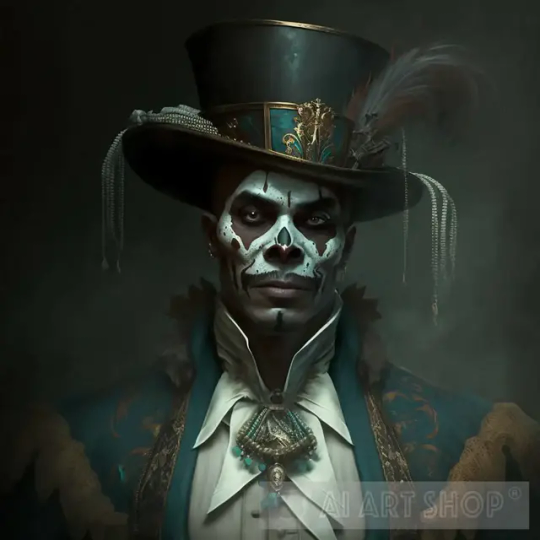
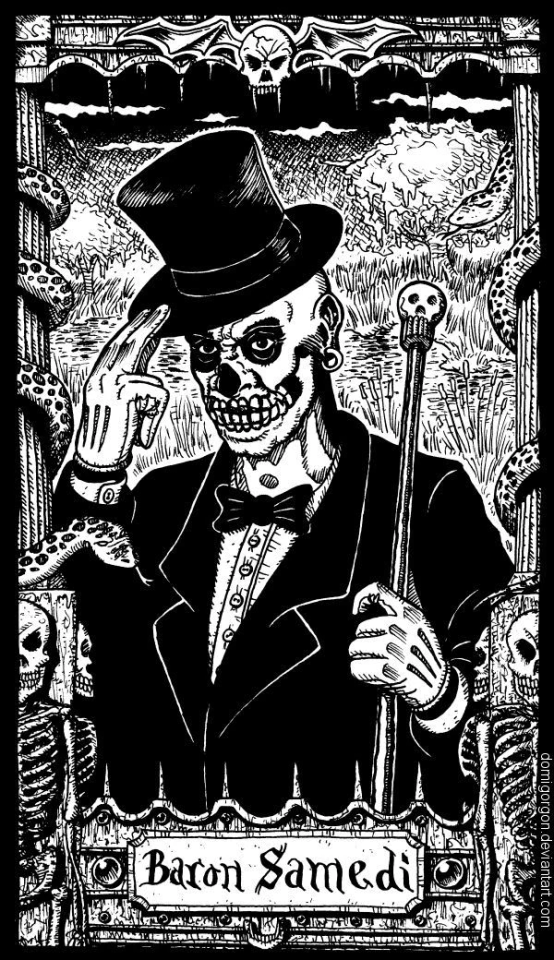

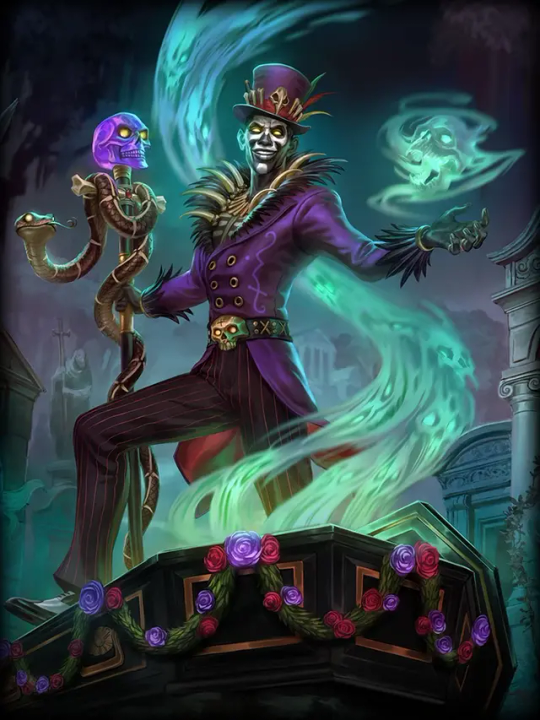
Baron Samedi (English: Baron Saturday), also written Baron Samdi, Bawon Samedi or Bawon Sanmdi, is one of the lwa of Haitian Vodou. He is a lwa of the dead, along with Baron's numerous other incarnations Baron Cimetière, Baron La Croix and Baron Criminel.
He is the head of the Gede family of lwa; his brothers are Azagon Lacroix and Baron Piquant and he is the husband of Maman Brigitte. Together, they are the guardians of the past, of history, and of heritage
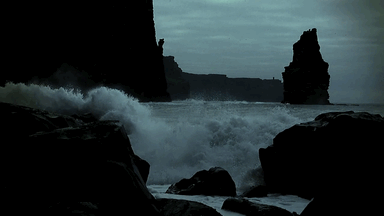
Baron Samedi is usually depicted with a top hat, black tail coat, dark glasses, and cotton plugs in the nostrils, as if to resemble a corpse dressed and prepared for burial in the Haitian style. He is frequently depicted as a skeleton (but sometimes as a black man that merely has his face painted as a skull), and speaks in a nasal voice. The former President-for-Life of Haiti, François Duvalier, known as Papa Doc, modeled his cult of personality on Baron Samedi; he was often seen speaking in a deep nasal tone and wearing dark glasses.
He is noted for disruption, obscenity, debauchery, and having a particular fondness for tobacco and rum. Additionally, he is the lwa of resurrection, and in the latter capacity he is often called upon for healing by those near or approaching death, as it is only the Baron that can accept an individual into the realm of the dead.
Due to affiliation with François Duvalier, Baron Samedi is linked to secret societies in the Haitian government and includes them in his domain.
Baron Samedi spends most of his time in the invisible realm of vodou spirits. He is notorious for his outrageous behavior, swearing continuously and making filthy jokes to the other spirits. He is married to another powerful spirit known as Maman Brigitte, but often chases after mortal women. He loves smoking and drinking and is rarely seen without a cigar in his mouth or a glass of rum in his bony fingers. Baron Samedi can usually be found at the crossroads between the worlds of death and the living. When someone dies, he digs their grave and greets their soul after they have been buried, leading them to the underworld.
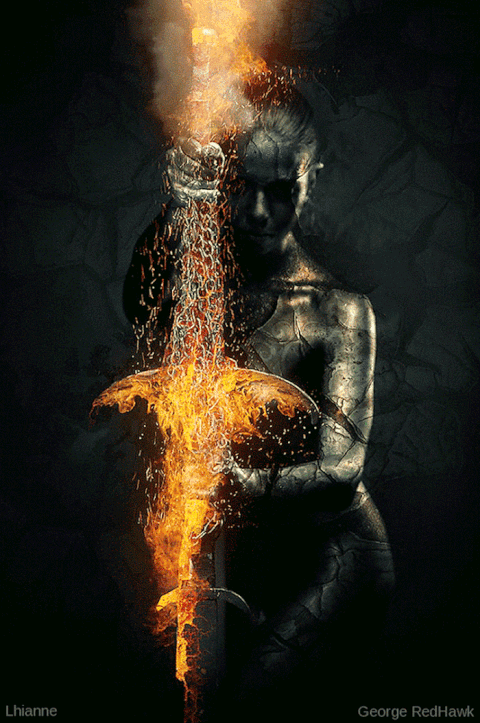
Baron Samedi is the leader of the Gede, lwa with particular links to magic, ancestor worship and death. These lesser spirits are dressed like The Baron and are as rude and crude but not nearly as charming as their master. They help carry the dead to the underworld

As well as being the master of the dead, Baron Samedi is also a giver of life. He can cure mortals of any disease or wound, so long as he thinks it is worthwhile. His powers are especially great when it comes to Vodou curses and black magic. Even if somebody has been afflicted by a hex that brings them to the verge of death, they will not die if The Baron refuses to dig their grave. So long as The Baron keeps them out of the ground, they are safe.
In many Haitian cemeteries, the longest standing grave of male is designated as the grave of Baron Samedi. A cross (the kwa Bawon, meaning "Baron's cross") is placed at a crossroads in the cemetery to represent the point where the mortal and spiritual world cross. Often, a black top hat is placed on top of this cross.
He also ensures that all corpses rot in the ground to stop any soul from being brought back as a zombie. What he demands in return depends on his mood. Sometimes he is content with his followers wearing black, white or purple clothes or using sacred objects; he may simply ask for a small gift of cigars, rum, black coffee, grilled peanuts, or bread. But sometimes The Baron requires a Vodou ceremony to help him cross over into this world

#baron samedi#lwa#african#afrakan#kemetic dreams#africans#afrakans#african culture#afrakan spirituality#haiti
175 notes
·
View notes
Note
Hello! I found out recently that Baron La Croix owns my head but I can't find much about him online. Is there anything you know about him?
Hello!
Unless you passed through some kind of ceremony done by a houngan or manbo, you did not find out that a particular lwa owns your head. That information can only be determined when you are taking part in specific rituals within Haitian Vodou. It can't be determined by spiritualists outside the religion, via a casual reading, or anything else.
Moreover, all of the Barons are aspects of death and putting death on someone's head as their head spirit is inviting them to enter death quickly. We don't do that; the Bawons and various Gede are not put on heads or named as the met tet because we don't want people to die before God determines it is time.
Evdn further, the ceremonies that assign a master of the head are ceremonies of life where death can have no place; none of the Barons or Gede are allowed to have a presence so they certainly wouldn't be placed to the head.
I am happy to discuss the specifics of how this was communicated to you privately, if you'd like. Feel free to send me a message.
10 notes
·
View notes
Note
I just found you and your YouTube channel today so I'm going on a spamming spree for all the lore I can find on here so I apologise for all the notifications 🥲 I really love your art and your voice !!
no problem at all hon, I'll let you work your way through the lore but here's some lore as a treat for you:
In NeXus, some characters are named after deities not because they are those actual deities but because in their world, they are the closest embodiment to them. Adonis says that he used to be known as Baron La Croix (a loa from Voudou), but he himself is not actually that spirit.
Typically people are given these names by those in authority as a status symbol to denote their exceptionalism in magic. If you've been paying attention then you'll also know that Asteroth is named similarly to Astaroth, a great duke of Hell and one known for his abilities of foresight and strategy. This name was given to him by his grandfather Asteroth Sinclair Senior.
That's all, happy lore hunting!
#mr. laveau#nexus asks#nexus#Nexus lore#asmr community#audio rp#audio roleplay#asmr rp#asmr roleplay#boyfriend asmr#asmr boyfriend
11 notes
·
View notes
Text
Baron Samedi vs. Papa Gede - Revisited
Many moons ago, I wrote this opinion piece regarding the differences between Baron Samedi and Papa Gede. I have since attempted to research this further, as it is necessary I revisit this subject.
It appears that many Westerners like myself come to believe that Baron Samedi and Papa Gede are one in the same, due to a comment that was made by Maya Deren in Divine Horsemen. However, if you look to the back of the book, Deren cites many other sources, including the American novelist Harold Courlander.
Below are quotes from Courlander’s (1944) “Gods of the Haitian Mountains”:
“…Some Haitians feel that BARON SAMEDI and GEDE NIMBO are the same…” (p. 356)
“...In some parts of Haiti GEDE NIMBO is thought to be identical with BARON SAMEDI…” (pp. 361-362)
SOURCE: Courlander, Harold. “Gods of the Haitian Mountains.” The Journal of Negro History, vol. 29, no. 3, 1944, pp. 339–72. JSTOR, https://doi.org/10.2307/2714821. Accessed 22 Dec. 2024.
Similar comments are made in Courlander’s (1960) The Drum and the Hoe:
“...Gede Nimbo, also known as Baron Samedi…” (p. 56)
“...In some parts of Haiti, Gede is thought to be identical with Baron Samedi…” (p. 323)
“...They are so closely identified that some Haitians feel that Baron Samedi is merely another name for Gede Nimbo…” (p. 323)
SOURCE: Courlander, Harold. The Drum and the Hoe: Life and Lore of the Haitian People. United States, University of California Press, 1960. Retrieved from: https://archive.org/details/drumhoe0000unse/mode/2up
Further context is provided in Courlander’s (1973) Haiti Singing:
“Gede Nimbo , also known as Baron Samedi. (Rada loa.) Athough Gede is inferior to Baron la Croix, he is still one of the most important of all the family. In fact, he is one of the most powerful deities of the whole Haitian pantheon. He guards the cemetery and protects the graves, especially those of children. But Gede Nimbo is not simply another loa, he is sometimes a personification of death itself. He is always spoken of as “dressed all in black.” While people may give “pitit lament” or small money to the other loa, they pay heavily to Gede Nimbo. He is not pleasant when aroused. (In Mirebalais, Dr. Herskovits received the impression that Gede Nimbo and Baron Samedi are different loa. In the south they are considered the same.) Dr. Elsie Clews Parsons, who visited the south coast of Haiti on a folk tale collecting trip some years ago, recorded the following impressions of Gede: “He is like Ogun [Ogoun], but ‘worse,’ he is a grande diable. He makes all kinds of motions to make you laugh, but you must not laugh at him, for if you do, he makes you ‘stop laughing,’ which means inversely that he makes you go on laughing forever against your will. Anything you touch, he takes and never returns, and you have to give him more and more. He smokes cigarettes, not cigars. He wears a coat and a hat, and carries a stick. He can make himself short or tall, ‘as tall as a mast.’ ” (p. 34)
SOURCE: Courlander, Harold. Haiti Singing. United States, Cooper Square Publishers, 1973. Originally published in 1939. Retrieved from: https://archive.org/details/isbn_0815404611/page/34/mode/1up
Although Courlander claims that Gede Nimbo and Baron Samedi are considered the same in Southern Haiti, this is contradicted by the source he provides.
Where George Simpson studied Vodou in Northern Haiti, Dr. Elsie Clews Parsons reported his observations from “a recent folk-tale collecting trip to the south coast of Hayti”. He clearly differentiates between Baron Samedi and Gede Nimbo, like so:
"On this higglety pigglety pantheon my notes read: Loi Gede or Gede-nibo talks through his nose (i.e. when he takes possession of any one). He eats only casaba and peppers and herring. He "ties his jaw" just like the dead, with cotton in the nostrils, for he is «master of the cemetery» mait' e cimetière). He is the "head loi". At the capital, Port-au-Prince, "most people have the loi Gede..." His papa loi (devotee) wears habitually (?) a white handkerchief around the head…." (p. 158)
“Loi Ba-un-Samedi (? gives or for Saturday). He is like Ogun, but "worse", he is a grande diable. He makes all kinds of motions to make you laugh, but you must not laugh at him, for if you do, he makes you "stop laughing", which means inversely that he makes you go on laughing forever against your will. Anything you touch, he takes and never returns, and you have to give him more and more. He smokes cigarettes, not cigars. He wears a coat and hat, and carries a stick. He can make himself short or tall, "as tall as a mast…."” (p. 162)
SOURCE: PARSONS, Elsie Clews. “SPIRIT CULT IN HAYTI.” Journal de La Société Des Américanistes, vol. 20, 1928, pp. 157–79. JSTOR, http://www.jstor.org/stable/24720068. Accessed 22 Dec. 2024.
(as a side-note, I fucking love how he uses the phrase “higglety pigglety pantheon”)
Did Courlander make a mistake, or did he correctly observe a regional difference in Haiti?
When reporting his observations in Haiti, Melville Herskovits supplied three different lists of loa from three different sources. He noted the contradictions between the lists, like so:
"Some of the inconsistencies and individual variations in the naming of the gods as demonstrated in these lists may be specified. Outstanding are the differences found in the manner of naming a single god, as when General Ogun is called Ogun Gallone or Papa Ogun, or when Aizan Damballa is listed as two loa, Mait' Damballa and Mait' Aizan..."
SOURCE: Herskovits, Melville Jean. Life in a Haitian Valley. New York, Octagon Books Inc., 1964. pp. 309-319. Retrieved from: https://archive.org/details/lifeinhaitianval0000hers/page/308/mode/2up
The point is, there are legitimate regional differences in Haiti. As a consequence of this, two different credible sources can give you very different answers to questions, including the manner in which certain loa are classified.
With this in mind, it was improper of me to make such accusations against Deren, and Hurston, with this degree of uncertainty. It is possible they were correct; without a time machine, it is impossible to say.
At that, this could potentially explain the representation of Baron Samedi in New Orleans - the “revitalization” may have been influenced by someone(s) from a region of Haiti where Baron Samedi was (is?) equated with Gede Nibo.
#commentary#Much like the Maman Brigitte article I will have to revise the old article regarding Baron Samedi#It is also misleading to claim that Papa Gede wears purple when he also wears black#His style and demeanor are just very different from how Baron Samedi is described
2 notes
·
View notes
Photo

Dans le vaudou, Baron Samedi (ou Baron Samdi, Bawon Samedi, Bawon Sanmdi) est avec ses autres incarnations Baron La Croix (symbole de l'individualité et de l'importance des petits plaisirs de la vie, puisque nous allons tous à la tombe), Baron Cimetière (protecteur des cimetières qui garde les morts dedans et les vivants dehors) et Baron Kriminel (vengeur, juge et punisseur des morts). Sa femme est Maman Brigitte.Il est représenté vêtu d'un chapeau haut de forme blanc, d'un costume de soirée, de lunettes de soleil dont un verre est cassé, avec du coton dans les narines.C'est l'esprit de la mort et de la résurrection, il se trouve à l'entrée des cimetières et se met sur le passage des morts Il sert également lors de l'approche du jour des morts à la vengeance des âmes errantes, des personnes persécutées, des sorcières et des consultantes des cultes vaudou. Il est invoqué avec l'aide de bourdons sur lesquels un charme est jeté sur leurs aiguillons selon la parole biblique « mort où est ton aiguillon ? ».Baron Samedi est considéré comme le maître de la mort, il décide qui peut rentrer ou non dans le monde des morts.
3 notes
·
View notes
Text
youtube
The Secret Mastermind of the Blackbeard Pirates
youtube comments
I always found it weird how Oda gave the name of arguably one of the most well-known and successful pirates to such a minor character, and always seemed to set him apart from the rest in the ways you mentioned. Also, if I had to guess a previous name for Lafitte, I would literally just go for Jean-Pierre, as that's a name in and of itself in French, and it references both the real life Lafittes by combining them together, much the same way the character of One Piece's Lafitte is a combination of the two.Show less
Jango who was also hypnosis, what did he do? He faked kuro's death by hypnotizing morgan! This definitely strengthens your idea.
The fact that he is able to go unnoticed by Hawk-Eye, the dude that is the reason Shanks probably learnt how to block Observation Haki, should terrify everyone honestly
The connections to the real life Lafitte are sick. The two death dates makes it seem like the character’ll be defeated at the fake age of 41/42, when he’s actually 94/95. Also, it’s entirely possible that someone with the Toshi Toshi no Mi used it on Lafitte at God Valley to make him ~3(?) years old, and then he had to grow up again in the West Blue (where God Valley was). Then that Devil Fruit user died before Bonney got the Toshi Toshi no Mi.
This theory actually crosses over with another theory I have jotted down somewhere. Have a look into "Baron Samedi" also known as "Baron La Croix". Laffitte's character design works really well with the Baron. Baron Samedi is also one of the Iwa of Haitian Vodou like "Joyboy".
I especially liked how you included Treble in the theory since I agree 100%. Oda often creates and older parent-like figure who influenced the villain to go down their dark path in the first place (Treble, Streusen, Higurashi and who knows, maybe even Gorosei).
Also, this works for me but I would take it farther than lafite. After seeing his arms, I think he's the model screech owl, screech owls were Hades sacred bird. And Cerberus his guardian. So I think lafite has been grooming black beard so that he can open the gate to Hades, or needs him to resurrect someone.
This would make a future Sanji fight a lot cooler. I've always felt like his opponent in the matchup was never very clear or satisfying, like him fighting Avalo or Burgess felt empty, but him fighting a major, big big deal former Rocks pirate with a bounty in the billions is hype. Also their roles are perfectly matched, as Sanji and Laffite are both the secret weapons, the 'spies' of their respective crew who go under the radar while the rest of the crew charges head on.
Lafitte having an interaction with St. Saturn after he gets downed by Luffy/Kuma/Bonney sounding even more likely now. Saint Saturn recognizing him or saying some shit like "I know who you really are." cause they both would've been at God Valley. I'm betting all my money on Lafitte being the one in that Blackbeard ship at egghead, I wonder how nobody has noticed the ship yet though.Show less
imagine if lafitte was the vice captain of the rocks pirates it would make him teachs rayleigh
@bottlepiecemuses
#one piece#op theory#one piece theory#op lafitte#Youtube#op theories#demon sheriff lafitte#demon sheriff laffitte#one piece laffitte#one piece theories#blackbeard pirates#marshall d. teach#op blackbeard
4 notes
·
View notes
Text
The Career of Jean Pache: From Soldier in the Service of the Revolution, Baron under the Empire, to Fervent Royalist during the Restoration
If you want more information about Sylvie Audouin, it's here: https://www.tumblr.com/nesiacha/776418727578189824/the-revolutionary-path-of-sylvie-audouin-daughter?source=share. For Xavier Audouin, it's here: https://www.tumblr.com/nesiacha/776762458733002752/the-life-of-the-revolutionary-xavier-audouin-from?source=share. For Jean-Nicolas Pache, it’s in two parts. The first part is here: https://www.tumblr.com/nesiacha/777295133948411904/jean-nicolas-pache-the-swiss-minister-of-war?source=share, and the second part is here: https://www.tumblr.com/nesiacha/778721992245477376/jean-nicolas-pache-the-swiss-minister-of-war?source=share.
It is true that, in comparison to his father Jean-Nicolas Pache, his sister Sylvie, and his brother-in-law Xavier Audouin, Jean Pache’s political journey may seem rather unremarkable, especially as he is the one least discussed in this family. Additionally, it is true that he had significant political disagreements with his father, and he has been accused of being an ungrateful son who abandoned his father—unlike his sister, who remained loyal to him and whose actions seem to align with supporting the Revolution (having accepted a title of Baron under Napoleon's Empire and later becoming a fervent royalist to the point of refusing to use her father’s name). Moreover, his political trajectory is the least known among the family members during the French Revolution.
But what is the truth? Is he also a victim of the same dark legend as his father, sister, and brother-in-law—one that needs to be broken? This is what we will examine.
Jean Pache was born on May 21, 1779. His full name was Jean-Antoine Marin-Pache. His parents were Swiss-born Jean-Nicolas Pache and Marie-Marguerite "Sylvie" Valette, an illegitimate daughter of Charles Eugène de la Croix de Castries, who briefly served as the Minister of the Navy in 1780. Their marriage was arranged because Castries held Pache in high regard after they met at the École de Génie in Mézières, where the future revolutionary developed a range of talents, including military engineering, a sharp intellect, and deep cultural knowledge, and formed a lasting friendship with Gaspard Monge.
According to the birth register from the Saint-Roch Parish, Jean Pache had as his godfather Jean Jaunot, a lawyer in Parliament at the Royal Abbey of Montmartre, and his godmother was his own grandmother, Jeanne Lallemand.
Jean Pache was the second and final child in the family. The family followed Rousseau's educational philosophy, teaching their son to gather herbs, give harp lessons to their daughter, and lead a pastoral life. According to Perquin, the wife of Jean-Nicolas Pache was very beautiful and a skilled musician. Through Castries' influence, Pache was appointed Controller of the King’s Household under Necker, though he later left this position to live in Switzerland. However, tragedy struck when Pache's wife passed away in 1786, a loss from which Pache never truly recovered. After her death, Sylvie and Jean were raised by their father and their paternal grandmother, Jeanne Lallemand.
Adrien See notes that Pache also instructed his two children in Swiss history. But in 1790, Pache and his family returned to Paris after the French Revolution broke out. Some say it was Monge, as a Jacobin, who persuaded Pache to return and support the Revolution. Louis de Launay argues instead that it was Monge's reports on the Revolution that led Pache to decide to return on his own. In any case, Louis de Launay described their reunion as follows (which, like Adrien See’s account, is not entirely reliable, though some parts may be true):
"A few days later, Monge received a letter from his friend Pache from Switzerland, asking what exactly the aims of the Revolution were. Informed by Monge, Pache immediately left Zug with his mother and two children and arrived in Paris via the Basel coach. Monge and his daughters went to meet the travelers to offer their assistance. But Monge’s daughters, who had not seen their little friends Jean and Sylvie in a long time, were surprised to see them. For Pache’s children were now dressed in Swiss style and spoke mostly German. This returnee, who had already introduced Monge to Marshal de Castries and thus to the Navy, would soon lead him to the early days of the Terror."
While it is possible that Pache’s children were dressed in Swiss style and spoke mainly German, we have a letter from Pache in French to his son just four years later, and Sylvie was certainly proficient in French, as shown by another letter where she signed a manifesto in 1792. The family also dined with collaborators, suggesting they conversed in French. It was during this time that Xavier Audouin could have met his future wife, Sylvie, in 1792. It’s hard to believe they managed to fully regain their French after speaking mostly German in 1790, although it is certainly possible.
When Pache was Minister of War, he would gather his collaborators around a table chaired by his mother, and Jean and Sylvie would join them. According to Avenel, quoting a Pache apologist, the names of these collaborators included Meusnier, du Falga, Vergne, Vincent, Hassenfratz, and Carnot-Feulins. One could assume that, like his sister, Jean used this opportunity to gain further political experience, even if he was very young.
An interesting fact: Jean Pache was spared by his father’s political adversaries, such as Dumouriez, unlike his sister Sylvie, who was criticized by other sources not citing Dumouriez, who was then unreliable when he claimed that she was "as ugly as she was mean." One might argue that this was because Jean was young, but Sylvie was only two years older than him. Perhaps it was simply the sexism of the time (considering the sexist remarks that Buzot reportedly made about her, although it’s possible he was referring to other women)? Or did Sylvie, at the age of 16, have a confrontation with Dumouriez that led him to make these spiteful remarks? I have yet to find the answer.
Jean-Nicolas Pache continued to educate his son (contrary to some claims) and wrote him a letter on February 10, 1793, while Jean-Nicolas had been dismissed from his position as Minister of War but had been elected Mayor of Paris: "Here is the good man, who knows how to rise with modesty and descend with dignity; he is in his place wherever he can work for the public good. There is nothing grand for a great soul; that is why a position, whether a little higher or lower, matters little, as long as virtue is practiced and one is useful to mankind."
When Jean-Nicolas Pache's papers were seized, it was revealed that, during the seizure of a sealed wooden box filled with papers belonging to the Pache and Audouin families, "an infinite number of papers related to physics, chemistry, and other similar subjects were found, all written by Citizen Pache, son, along with a large quantity of letters from him to his father."
During the arrest of his father, grandmother, sister, and brother-in-law on the night of the 21st of Floréal, Year II, contrary to what Wikipedia says, there is no evidence of Jean Pache’s imprisonment. The only trace of any misfortune that might have affected Jean Pache comes from a letter written by Xavier Audouin from prison on the 17th of Vendémiaire, Year III, who, at times, is not a reliable narrator.
Here is the letter:
"Citizens Representatives, detained for more than five months, I kept silent during the first four months, necessarily.
These men you punished, those who still deserve to be punished, subjected me, my father, my wife (aged 16 and nursing a child), her 14-year-old brother, and her 80-year-old grandmother, to the most rigorous and unjust secrecy.
The 9th of Thermidor restored my right to communicate with you. I have used this means only once. Because my wife and child obtained justice, I considered my personal pain to be of little importance.
The extraordinary volume of cases I saw you dispatch led me to believe you could not delay in addressing my case.
I could also add that, wishing to be tied to my father’s fate (Pache), whose arrest may have served as a pretext for mine, I had flattered myself that you would recall the good he did, and that when you liberated him from the persecutions to which he is unjustly subjected, I would feel the effect of that as well.
Finally, the neglect we seem to be in avoids me from mentioning that I still do not know the reasons for the severity exercised against us. Having asked for them in vain, I reviewed my life from the cradle and found no act or thought that would not be worthy of a good citizen.
Nevertheless, I did not help overthrow the convents and palaces only to see myself imprisoned among the debris. If my detention is motivated, I must be judged. If it is not, it must cease. In any case, I ask for liberty or death."
However, by this time, Sylvie and Xavier had not yet had their first child, Léonard Audouin, born on November 29, 1795. While there are letters and writings confirming the imprisonment and secret detention for 100 days of Pache’s mother and Sylvie, there is no evidence regarding Jean Pache’s imprisonment. Nonetheless, it is not impossible that Jean Pache may have undergone an interrogation, which Xavier Audouin may have been trying to denounce. But this is just a hypothesis.
One might wonder who took care of Jean Pache during this time. Surely, it was friends of Jean-Nicolas Pache, perhaps even Gaspard Monge, who had always been there for his friend during difficult times.
Unfortunately, while Sylvie and Jeanne Lallemand were released after 100 days in prison, the imprisonment continued for Jean-Nicolas Pache and Xavier Audouin (along with other prisoners, including Clémence, Marchand, Héron, Bouchotte, Daubigny, Jourdeuil, Rossignol). The right-wing had regained power following the Thermidorian Reaction, and once again, Pache and Audouin were in grave danger of death.
When discussing public loyalty during these dangerous times, Sylvie's loyalty to her husband, Xavier ( and by extension to her father), would become famous. Jean, at his young age, was no less loyal.
It seems that Jean and Sylvie divided tasks between them. Sylvie would primarily focus on helping defend her husband, Xavier, while Jean took on the defense of their father.
Moreover, on the 7th of Brumaire, the date when the tribunal ordered the release of Jean-Nicolas Pache and Xavier Audouin, Jean Pache, the son, was present in the tribunal to represent the decree allowing the release of his father and brother-in-law.
While there is evidence that Sylvie had already developed political convictions when she signed a manifesto against Louis XVI (addressed to the people, by the Patriotic Society of Luxembourg) in 1792, alongside prominent figures like her father, her future husband, and Pauline Léon within this society, it appears that Jean Pache was also politically active. According to Pierquin, found in the archives of the Ministry of War, he voluntarily enlisted in the Paris artillery company on July 1, 1793, and left on November 28, 1794 (strangely, during the imprisonment of his father and brother-in-law). He then became a student at the École Polytechnique on December 27, 1798. His contribution to the French Revolution was present, though not as prominent during the Directory period as Pache and Audouin (though, to be fair, Jean Pache was still young at that time).
I found no trace of what happened to him immediately after Bonaparte’s coup d’état, unlike the Audouin couple and Jean-Nicolas Pache.
Nevertheless, this did not prevent Jean Pache from continuing to rise through the ranks.
He became a sous-lieutenant at the École de Châlons on November 22, 1800, and then a second lieutenant in the 2nd Foot Artillery Regiment on September 23, 1801. He was sent to the École d'Artillerie de Châlon on October 8, 1801. He joined the 2nd Artillery Regiment on July 12, 1802. He became first lieutenant in the 1st Cavalry Artillery Regiment on July 11, 1806, and aide-de-camp to General Ruty on January 31, 1807. He was promoted to captain in the 5th Cavalry Artillery Regiment on February 2, 1808. He was then employed at the Klingenthal Arms Factory on October 2, 1809, and at the Charleville Factory on June 21, 1810, before returning to Klingenthal on March 28, 1811. He was attached to the Artillery Committee on August 8, 1811, and became first captain on October 5, 1811. He was promoted to squadron leader on the artillery staff on February 13, 1813, and battalion chief in the Imperial Guard Artillery on May 14, 1813. He became lieutenant-colonel on June 21, 1814, and was attached to the Artillery Committee on June 1, 1816. He was made colonel on January 23, 1822, and was employed at the artillery depot on March 16, 1822. He became colonel of the 3rd Artillery Regiment on August 11, 1830, and retired on June 10, 1831, then officially retired for seniority by an order on April 7, 1833.
He participated in various campaigns: 1793-1794 in Vendée; 1805-1806 in Italy; the Grand Army in 1807; the Army of the North in 1809; Germany in 1811; Russia in 1812; Saxony in 1813; and France in 1814-1815.
He was awarded the Legion of Honor on March 3, 1807, became an officer on October 11, 1812, was made Baron of the Empire in 1813, and was decorated with the Order of Saint Louis on November 1, 1814.
Although he became a Baron of the Empire in 1813, he became a fervent royalist during the First Restoration. He renounced his family name "Pache" (due to not only Jean-Nicolas Pache's strong revolutionary stance but also likely because of his father's role in the death of Marie-Antoinette) and preferred to be addressed as Colonel Baron Jean by his guests. He frequented Count de Broyes, who lived in the Château de Jandun near Thin-le-Mouthier, and whenever he traveled, he would visit there. On the other hand, he neglected his father, who, after the death of Sylvie and his granddaughter Sylvie Félicité, lived alone in a severely depressed and neglected state.
One might wonder whether Jean also distanced himself from his sister and brother-in-law.
Many criticized Jean for being inconsistent: first a servant of the French Revolution, then benefiting from Bonaparte’s regime by accepting a noble title, only to become a fervent royalist. Others accused him of completely neglecting his father out of shame for his revolutionary activities.
Regarding the first accusation, while some elements do support it (being a baron of the Empire and later becoming a fervent royalist), it should not be forgotten that, in the context of the French Revolution, Jean Pache was "only" a soldier, not a politician like others. As for Napoleon, he earned his noble title through merit according to the rules of the Empire (though, in reality, the granting of noble titles based on merit or not under the Empire is much more complex than that). One only needs to look at his achievements, as we have seen. It should also be noted that, according to Pierquin, he became a royalist during the first Restoration, not during the second, which was inevitable. Therefore, we can argue against the idea that he was a "weathervane" or opportunistic.
As for the accusation of familial disloyalty toward his father, this is indeed more complicated. Sylvie was always faithful to her father until the end, and Xavier Audouin, Pache's son-in-law, was also loyal (despite initially being on a Jacobin watchlist, he eventually joined Bonaparte as his secretary and later became a royalist). They both continued visiting Pache, regardless of the political period. Jean, on the other hand, distanced himself from his father. Yet, when he was 14, Jean had been there for his father during a time of trouble. Additionally, Pierquin suggested that despite the role Jean-Nicolas Pache played in Marie-Antoinette's execution, Jean’s leniency could be attributed not only to Xavier Audouin's intervention and his grandson's connections in royalist circles but also to Jean Pache's own efforts. Thus, it can be said that he contributed to the protection of his father and was, in a way, loyal to him.
Another accusation Jean Pache faced was taking a share of the inheritance intended for his father's two favored students (Mademoiselle Stevenin and Monsieur Chardon) once he had withdrawn from politics to focus on agriculture. These were philosophical works that he had bequeathed in his will in 1818. However, in 1840, Jean Pache claimed this document (the philosophical treatise) from Monsieur de Chardon in a manner "impertinent," according to Pierquin, though Chardon saw no issue with it. It was published four years later, one year after Jean Pache’s death, although Chardon was not informed beforehand. While one could view Jean's actions as unscrupulous and questionable, it is possible that he did so as a way of rehabilitating his father’s legacy.
Jean Pache passed away on April 23, 1843, in Paris at his home on rue Las Cases.
Sources :
Pierquin
Lenôtre
Le procès Pache (extraits du dossier) The Pache Trial (Excerpts from the File)
#frev#french revolution#napoleonic era#empire#monarchy#pache#1790s#1800s#restauration of bourbons#To be honest#I don't find the character sympathetic at all.#But I think it's important to try to make hypotheses in order to understand it.#I know that in reality#the titles of nobility under the Empire were not necessarily given based on merit; it's more complex than that#but I simplified it for better understanding of the post.#history#france
1 note
·
View note
Text
Godefroy de Bouillon

Le matin se levait sur Bouillon, enveloppant le château d'une brume légère qui se dissipait lentement sous les premiers rayons du soleil. Les murs de pierre, témoins de tant d'histoires, résonnaient des préparatifs frénétiques des hommes qui s'apprêtaient à partir pour une aventure qui marquerait l'histoire. En ce jour de 1097, le duc Godefroy de Bouillon, se tenait sur le parvis de son château, entouré de ses barons et de ses fidèles compagnons.
Les cris des hommes, le bruit des armures et le cliquetis des épées créaient une symphonie de bravoure et d'excitation. Godefroy, vêtu de son armure étincelante, observait ses hommes avec fierté. Chacun d'eux avait répondu à l'appel de la croisade, prêt à quitter leur terre natale pour défendre la foi chrétienne et libérer Jérusalem.
« Mes amis, » commença Godefroy, sa voix résonnant avec force, « aujourd'hui, nous faisons un pas vers l'inconnu. Nous partons pour la Terre Sainte, pour répondre à l'appel du pape et pour défendre notre foi. »
Les barons, parmi lesquels se trouvaient des figures respectées comme ses frères, Baudouin de Bouillon et Eustache de Bouillon, acquiescèrent avec enthousiasme. Leurs visages étaient marqués par la détermination, chacun conscient des dangers qui les attendaient, mais également de l'importance de leur mission.
« Nous avons rassemblé des hommes de toutes parts, » poursuivit Godefroy, « des nobles et des paysans, unis par un même but. Que notre courage soit notre guide et notre foi notre force. »
Un murmure d'approbation parcourut la foule, et les hommes levèrent leurs épées en signe de promesse. Godefroy se tourna vers le ciel, une prière silencieuse sur ses lèvres, demandant la protection divine pour lui et ses compagnons.
« N'oublions jamais pourquoi nous partons, » ajouta-t-il, son regard se posant sur les visages de ses barons. « Nous allons libérer ceux qui souffrent, défendre notre terre et notre foi. Jérusalem nous attend. »
Les tambours résonnèrent, marquant le début de leur voyage. Les hommes se mirent en marche, leurs bannières flottant au vent, symboles de leur détermination. Godefroy, à la tête de la troupe, ressentait le poids de la responsabilité sur ses épaules, mais il savait qu'il n'était pas seul. Ses barons marchaient à ses côtés, prêts à affronter les défis qui les attendaient.
Alors qu'ils quittaient Bouillon, les habitants des villages alentours se rassemblaient le long des routes, offrant des prières et des bénédictions pour la sécurité des croisés. Les enfants agitaient des drapeaux faits maison, et les femmes jetaient des fleurs sur leur passage, un geste d'espoir et de soutien.
Le chemin vers Jérusalem serait long et semé d'embûches, mais pour Godefroy et ses barons, chaque pas était une promesse de foi et de solidarité. Ils savaient que leur destin était désormais lié à celui de milliers d'hommes, tous unis par un même rêve : voir la croix flotter sur les murs de Jérusalem.
Alors que le château de Bouillon s'éloignait derrière eux, Godefroy leva son épée vers le ciel, un cri de guerre s'élevant dans l'air frais du matin. « Pour le Christ ! Pour Jérusalem ! » Les échos de sa voix résonnèrent dans les cœurs de ses hommes, une promesse d'honneur et de bravoure qui les accompagnerait tout au long de leur périple.
#Godefroy de Bouillon#first crusade#première croisade#11th century#medieval history#history medieval#moyen âge#fanfic#histoire de france
1 note
·
View note
Text

LA FUREUR EST CRUELLE, ET,
LA COLÈRE EST IMPÉTUEUSE, MAIS,
QUI RÉSISTERA DEVANT LA JALOUSIE ?
.
OUI, UN AMI BON ET FIDÈLE, QUI PEUT LE TROUVER ?
.
CES GENS-LÀ SONT PÉNIBLES, PITOYABLES ET PATHÉTIQUES.
.
(02 TIMOTHÉE 03 : 01 - 07)
.
LE PAIN DU MENSONGE,
LES ENNEMIS DE LA FOI,
LES ENNEMIS DE LA CROIX,
LES ENNEMIS DES GENS DE BIEN,
LA CONFUSION DU SERPENT ET LA HONTE DU SORCIER,
.
LA VICTOIRE ET LE TRIOMPHE DES ENFANTS DE DIEU,
.
OUI , LE BIEN TRIOMPHE TOUJOURS DU MAL.
.
( 01 PIERRE 02 : 11 - 17)
.
N'IMITEZ PAS LE MAL ET NE VOUS LASSEZ JAMAIS DE FAIRE LE BIEN, PARTOUT AUTOUR DE VOUS, PARTOUT EN TOUS LIEUX, EN TOUS TEMPS ET EN TOUTES CIRCONSTANCES CHAQUE JOUR QUE DIEU FAIT ET CE DURANT TOUTE VOTRE VIE.
.
( PHILIPPIENS 04 : 01 - 09)
.
POUR DIEU, LE PEUPLE ET LA PATRIE.
.
POUR LA PAIX, LE PROGRÈS ET LA PROSPÉRITÉ.
.
POUR L'ORDRE, LA JUSTICE ET LA DÉMOCRATIE.
.
POUR DES ÉLECTIONS LIBRES, APAISÉES ET TRANSPARENTES.
.
(01 PIERRE 03 : 08 - 17)
.
LE CONSACRÉ MINISTRE DE DIEU,
ELOHIM !
SA MAJESTÉ L'ÉTERNEL DIEU LE PÈRE DE GLOIRE,
LE DIEU PÈRE CRÉATEUR ET NOTRE SAINT SAUVEUR
LE DIEU UN ET INDIVISIBLE, LE SEUL ET LE VÉRITABLE, L'ALPHA ET L'OMÉGA,
LE DIEU QUI NE MEURT PAS, QUI NE MENT POINT ET NE SE RENIE JAMAIS.
LE BEAU, GRAND, FORT ET TOUT PUISSANT ÉTERNEL DIEU VIVANT PARTOUT TOUT LÀ HAUT DANS LES CIEUX ET ICI-BAS SUR TOUTE L'ÉTENDUE DE LA SURFACE DE LA TERRE DES HOMMES.
LE DIEU QUI EXISTE ! ET QUI EST !
LE RENUMERATEUR DE TOUTES CHOSES.
.
( 01 PIERRE CHAPITRE 01)
.
L'AMI DE DIEU,
.
( PROVERBES 21 : 30)
.
L'ÉLU, ( THE ONE)
LE SAINT - ONT - LE MOINE,
LE RÉVÉREND LE BARON ABIATHAR,
.
LE PÈRE DE LA PROSPÉRITÉ,
LE PÈRE DE LA SURABONDANCE,
LA MAIN DU ROI, DIEU, LE ROI DES ROIS.
.
( TITE)
.
DIEU BÉNISSE RICHEMENT TOUTE LA RÉPUBLIQUE DE LA CÔTE D'IVOIRE QU'ON AIME ET QU'ON PRÉFÈRE TOUS.
.
( ROMAINS CHAPITRE 01)
( ROMAINS CHAPITRE 12)
( 01 CORINTHIENS CHAPITRE 1
( GALATES CHAPITRE 01)
( GALATES CHAPITRE 05)
( PSAUME 27)
( PSAUME 37)
( PROVERBES CHAPITRE 09)
( PROVERBES CHAPITRE 10)
0 notes
Text
Voodoo Q&A
Anonymous asked:
If someone is visited by both an Orisha and a Lwa is there any meaning to it? Hi, not much. Spirits they tend to wander around sometimes and pop up in random places, doesn't matter if someone has ether have or has had connection with them.
It really requires reading with the appropriate priests. For some, a random encounter doesn't mean anything without other evidence with it. For others, a encounter could be a beginning of something new. The best thing is to are to get readings from legitimate, verified priests of that religion. Hope this helps!
Anonymous asked:
Can Baron La Croix be on my head?
Hi, One must passed through some kind of ceremony done by a houngan or manbo/ priest or priestess of voodoo. A reading needs to be done. It's the only way to find out which particular lwa owns your head.
It can't be determined by spiritualists outside the religion.
But all of the Barons are aspects of death and putting death on someone's head because it's believed it can invite that person to enter death quickly.
We would want that. The Bawons and various Gede are not put on heads or named as the met tet because we don't want people to die before God says it's time.
After the reading the ceremonies that assign them as your master of the head are ceremonies of life. So death wont have no place in it.
Barons or Gede sometimes do.show them selves or want to help someone, but there not allowed to be presence so they certainly wouldn't be a Met Tet.
Anonymous asked:
How can I serve the Gede? All Gede are different and want different things. Piman is a good basic Gede drink, but not all Gede will likes it. Most Gede will accept black, white, and purple colors, but that can also vary on tradition. Candles, black or purple is what I use, cigars, rum I give them baked bead is sometimes put out as a offering. It was done at the fet I was at.
The Saint? There are lots of different Saints for Gede as well. Gede service depends on where you are from and how you have been taught. But St Gerard Majella is a good saint for most Gede in general!
#voodoo church#like and/or reblog!#spiritual#follow my blog#google search#ask me anything#new orleans voodoo#haitian vodou#gede spirits#questions and answers#Q and A
2 notes
·
View notes
Text

Comité international de la Croix-Rouge
Vase décoré, don du Baron de Geer. En souvenir de la Baronne de Geer, née Henriette Krieg, petite-fille du général Guillaume-Henri Dufour.
Vase offert au Général G. H. Dufour par le Roi Frédéric Guillaume 1er de Prusse le 27 avril 1869, lors de la Conférence tenue à Berlin par les gouvernements signataires de la Convention de Genève et les Sociétés de Secours aux militaires blessés et malades.
Le vase et les deux statuettes sont en porcelaine, le socle et les deux manches sont en bronze.
0 notes
Text
My Final Request || SRRP
It wasn't unusual for the Lady Yvette Toussaint to call upon Bones for a task. After all, she owned him. No, sorry--"indentured servant" was the proper phrase. He just had to do whatever she wanted until he could earn enough to buy his freedom.
Little did she know, he was getting close. Blackmailing Mr. Smee into doing his bidding had been extremely successful, and he was seeing tremendous dividends from the fine Lady Whistledown for acquiring a gentry mouthpiece. Just a few more tasks and he'd be free.
Soon enough, she wouldn't be calling on him like this anymore.
He entered her chambers, where she had summoned him. While he had been expecting her to bark some sort of trivial order, he instead found her at the standing mirror, looking through it pensively. He opened his mouth to speak, but she moved first, waving her hand in a motion he knew meant to lock the door.
That was his first indication something was wrong.
He silently shut the door behind him before locking it. Then he turned to her.
"What do you want?" He asked, bluntly. With doors closed like this, he didn't need to put up the pretense of fealty or respect. She knew his boorish past, just as he knew her hollowed heart.
Piercing blue eyes darted to meet his in the reflection of the mirror.
"I need you to do a job."
His mouth twitched into a frown. "What kind of job?"
"The kind that ends in a freshly dug mound."
He gave a small scoff and a click of his tongue, looking away from her. He knew exactly what it meant. It had been many years since she's demanded the death of an inconvenience. The second Lady de la Croix, the Baron himself--a pile of bodies on which Yvette could climb her way to the top. While Bones was not fool enough to think she had overcome this bloodlust, he'd perhaps foolishly hoped there wouldn't be a need for it.
One like Bones could not dare to dream.
"Who?" He finally asked.
"I assume you've seen Laurette flaunting about with the kitchen boy."
Bones frowned. "Kingsley?" He didn't know the lad very well, but over the course of this last month, many of the Kings' servants had come into contact with the servants of the households, if only from the back and forth of trying to please a large crowd of aristocracy.
"That's the one," she replied simply, as if she were pointing out a person at a dinner party, and not proclaiming the murder of an innocent.
His brow furrowed. Up until this point, she had only ever requested he get rid of nobles, empty out vacant titles that Yvette and her family might snatch up for themselves. Never before had she asked for a commoner. "I don't understand--why?"
Yvette finally turned away from the mirror to face him. "Laurette is on the cusp of courting a great match, perhaps even a Duke, but she is getting distracted. He needs to go."
"But--what harm is a little distraction? She's still participating in the season, attending all of the events. Are you worried she'll elope with him?"
A twinge of disgust shot across her face, and she scoffed. "We cannot allow it to even be a possibility. Laurette is on a dangerous path, very near following in the footsteps of her mother."
Bones winced slightly and looked away. He'd played an instrumental role in the death of the Baron's second wife, whom was being cheated on with Yvette's sister. The plan had been simple: with the Lady de la Croix gone, the mistress would then become the wife and take the title for herself. But at the last moment, shortly after Laurette was born, the newly appointed Lady de la Croix got cold feet, and disappeared into the night.
Yvette had been devastated, but Bones was left with a hollowness that would always remain. He'd killed a person, and nothing came of it. Even in his worst days as a pirate, he'd never been so callous and cruel. He had killed, but there had always been a justification, whether self-defense or survival. This was nothing. Deadly means to a deadened end.
Yvette took his silence as acceptance, and continued on. "There will be no poison. This needs to be completed before the opening of the final ball."
His stomach churned and his teeth grit, before blurting out, "No!"
A palpable silence followed. Her eyes bore holes through him, but he held her gaze, determined and steadfast in his refusal.
"No?"
"You heard me. I won't do it. I'm done being a gravedigger for corpses that never needed to exist. You don't know if anyone will actually propose, and a young boy's life doesn't need to violently end so you can--"
His words were replaced by a guttural gurgle in the back of his throat, pain suddenly shooting through every inch of his body. His insides broiled with a fiery rage, as if his very bones were being stretched, threatening to pierce through him. When he looked up, he could see through his tears Yvette standing there, with her hand raised casting a spell.
She told the world she was a divination specialist, much like her sister before and niece after. Bones was the only one who knew that her true magic was much darker still. She would "predict" the illnesses and downfalls of many, only to fulfill those prophecies with her own necromantic subterfuge. Now that darkness was pointed at him.
"Do you forget to whom you belong?"
She twisted her wrist and another wave of excruciating pain swept through him, bringing him to his knees. He managed to snap out an arm to hold him steady, keeping him from collapsing completely. Horrid grunts and gurgles sounded through grit teeth, but he bared them to her, using whatever strength he had to lift his head and meet her gaze.
"So-- what? I-it's either do what you say or I die? Is that it?" He growled, before spitting at her feet. "Do it, then! Cover up your own murders for once, you cowardly bitch--" The last word choked in his throat.
But just as quickly and powerfully as it had seized him, its grip subsided, leaving him only when a dull throb across the whole of his body. The sudden relief elicit a gasp from him, followed by confused panting.
"No, I don't think I will," she said simply as she released the spell. "I have an alternative proposition for you."
He couldn't bring himself to speak, limbs still shaking in recovery. Once more, she took his silence as a sign to continue.
"In exchange for this deed done, I will give you that which you've always sought--your freedom."
He grimaced. He'd nearly saved up what he needed and now he'd have to cross the finish line dragging behind the corpse of an innocent young boy?"
"Fuck off," he growled, reaching up to wipe some of the excess spittle off his face.
"More so than that," she continued, completely ignoring him, "I'm willing to offer you in cash the sum total we agreed upon for your release. Furthermore, I will provide you departure out of London and pay for your travel wherever you may choose to go."
Bones froze. He couldn't believe what he was hearing. In truth, he hadn't planned much ahead when he'd thought about his eventual freedom. Yes, he'd have spent every coin he had on it, but being his own man would make that worth it.
But freedom didn't put food on your plate. It didn't put a roof over your head. Even if he managed to find another job immediately, he would be living in squalor for God knows how long, with very little means to build himself back up.
If he accepted her proposal, he would have twice the amount of money he began with and a one way ticket to build a brand new life wherever he desired. He wouldn't have to work. He wouldn't have to suffer. He wouldn't have to endure the way he'd always endured for over five decades of his life.
It was everything he ever wanted.
And Yvette knew it.
Panting softly, he sat back on his legs, muscles still groaning in pain. Suddenly, long, delicate fingers were placed under his chin, tilting his head upwards. Once more, his gaze met with blue eyes, now much softer in the way they bore down on him, like a mother looking onto beloved son.
No, that wasn't right. It wasn't a love, but rather the pity of a person about to put down their sick animal. Her empty, sympathetic smile sent chills down his spine, which he wished once more would pierce through his skin.
"Mr. Bonhomme," she said, sweetly, a title she only ever used when they were out in public, where decorum was needed. "This is my final request to you. Will you do it?"
He wanted to fight. To tell her to fuck off, to kill him, that he was done doing her dirty work. To whip his head and bite her fingers and wipe that terrible smile off her face.
But he didn't. Because the truth was, he was tired of fighting. All his life he had fought to survive, on the hopes that someday he might be able to live freely. Now, that dream was finally within reach.
A shaky exhale passed through quivering lips that parted to say--
"Yes, my Lady."
1 note
·
View note
Text

Character Name: Baroness Paulette de la Croix - Khan
Title/occupation: Baroness of Foxgarden Manor
Magick Status: Mundus
Biography:
When Paulette's mother died and the Baron de la Croix replaced her quickly with a new wife, she was too young to really care. But when the woman who raised her fell ill and died, only to be replaced by her father's mistress, Paulette was enraged. And when she died, she felt nothing.
When her father died and the barony passed down to her, she was relieved. And almost immediately she entered the season to marry. When both Dukes she was courting chose others over her, Paulette chose to marry the handsome widower, Shere Khan, a military who already had a daughter. Almost immediately, Paulette made she got pregnant to ensure the heir of Foxgarden would be her child.
You can't trust anybody fully, not even your own sisters that you raised because none of your parents could be bothered.
Paulette did not love Shere when she married him, but she didn't think he loved her either. Even as she did grow to love him, she suspected he might not love her. Hence, despite three children between them and her now pregnant with their fourth, Paulette has been seeking company in other men. Especially since their marriage has become strained recently.
But affairs and a lukewarm marriage are better than a divorce-- no, Paulette would never. While Paulette is pregnant with her fourth child, initially hoping for a boy after daughters Delphine,Manon, and Inaya, Paulette is now secretly half-hoping she had a fourth daughter, so that she has to keep trying for a boy and her husband won't be too quick to suggest they part ways. What scum of the earth divorces a pregnant wife, right?
0 notes
Photo
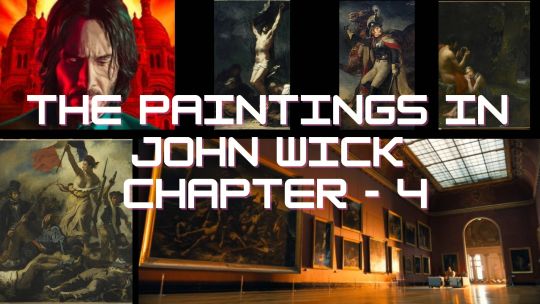
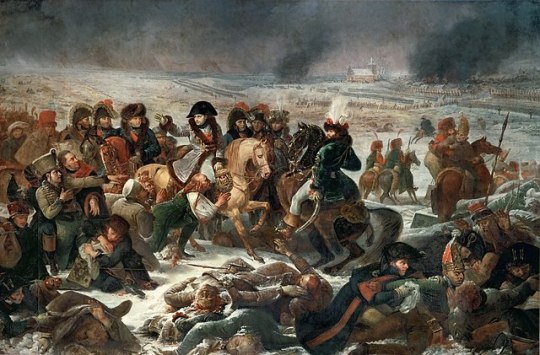

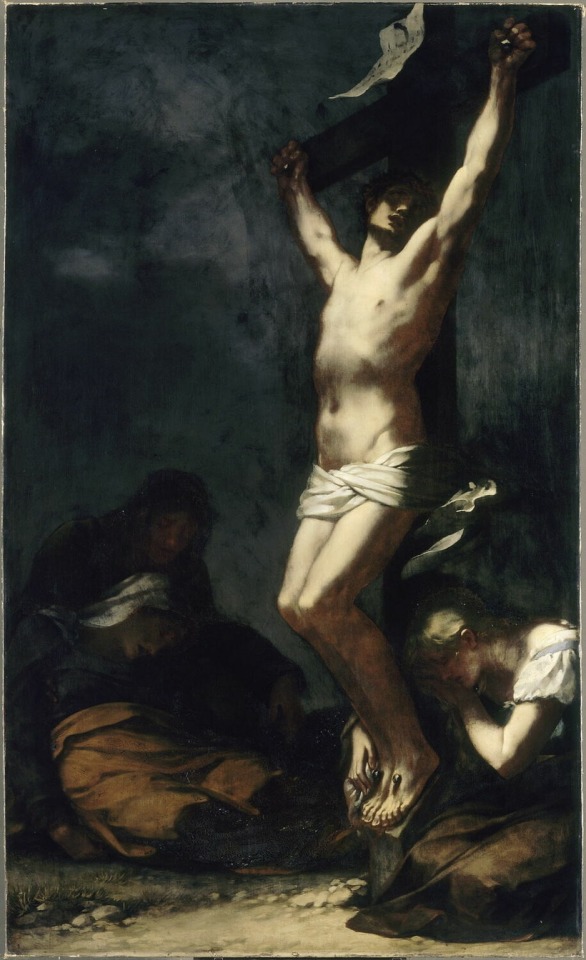

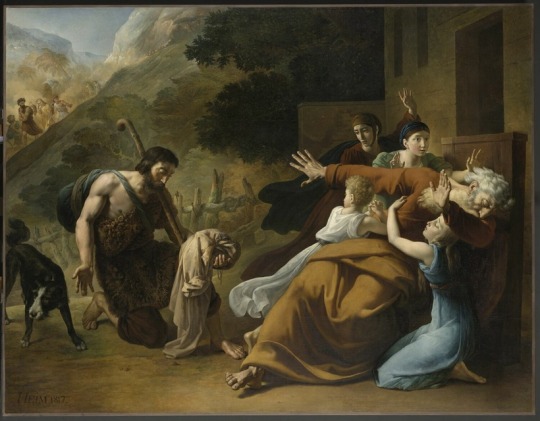




(The paintings in John Wick Chapter 4 | Paintphotographsから)
(Google訳)「ジョン・ウィック第4章」の絵画 : 絵画の背後にある象徴性を解読する ジョン・ウィック チャプター4にはどんな絵が描かれていましたか?ジョンウィック4の絵にはどんな意味があるのでしょうか?それらは根底にあるプロットラインやストーリーにとって重要な意味を持っていますか?本物の美術館で撮影されたのですか?これらの興味深い質問に対する答えを見つけるには、読み続けてください。
映画に登場する絵は確かに本物です。 「ロング・ウォーク」シーケンスとしても知られる、ジョン・ウィック第 4 章のアート ギャラリーのシーンは、フランス、パリのルーブル美術館の通称��赤い部屋」として知られる 700 号室で撮影されました。
The following paintings and artworks appear in the Long Walk sequence. In order of appearance
Napoléon on the Battlefield of Eylau, oil on canvas, by Antoine-Jean Gros, 1807-1808
The Wounded Cuirassier, oil on canvas by Théodore Géricault, 1814
The Raft of the Medusa, oil on canvas, by Théodore Géricault, 1818-1819
Le Christ sur la Croix, oil on canvas by Pierre-Paul Prud'hon, 1822
Paysage: Thésée poursuivant les Centaures, oil on canvas, by Achille Etna Michallon, 1821
The Barque of Dante, oil on canvas by Théodore Géricault, 1822
Liberty Leading the People, oil on canvas by Eugène Delacroix, 1830
La robe ensanglantée de Joseph apportée à Jacob, oil on canvas by François-Joseph Heim - 1817
Daphnis et Chloé, oil on canvas by François Baron Gérard, 1825
Paintings behind Bisset de Gramont (1:32:19 -1:32:23)
The Death of Sardanapalus, oil on canvas by Eugène Delacroix, 1827
A Young Tiger Playing with Its Mother, oil on canvas, by Eugène Delacroix, 1830-1831
David jouant de la harpe pour le roi Saül, oil on canvas by Antoine-Jean Gros, 1822
(ii) Mairie des Lilas subway (1:47:40 - 1:50:27)
The Incredulity of Saint Thomas, oil on canvas by Caravaggio, 1602
The Feast of Herod (The Killing of John the Baptist)
- - - - - - - - - - - - - - - -
Google翻訳
0 notes
Text
BARON SAMEDI vs. PAPA GUEDE
Why and how the two are confused for each other
Companion piece to: https://the-girl-who-didnt-smile.tumblr.com/post/761164319058739200/the-whitewashing-of-maman-brigitte
In the original version of this post, I accused Maya Deren of being the source of the claim that Baron Samedi and Papa Guede are one in the same. Upon researching this further, I do not think this was a fair accusation. Similar comments can be made towards Zora Neale Hurston. I revisited this essay to address this issue, as it is possible that Deren and Hurston’s comments reflect a real regional difference that exist(ed) in Haitian Vodou.
This should also be obvious, but I have no Haitian heritage, nor am I an expert on this topic. In the past, I was really ignorant about the differences between Baron Samedi and Papa Guede. This essay represents my attempt to research this subject. I apologize in advance for any mistakes that may be present.
Many Westerners like myself believe that Baron Samedi and Papa Guede are the same, or two aspects of a single lwa. Where does this notion come from?
One of the most important foreign authors in changing the public perception of Haitian Vodou is Maya Deren. Although other Westerners published books about Vodou before her, she was able to balance factual accuracy with a degree of eloquence that reached a mass audience. It comes as little surprise to me that an author of Eastern European heritage could resonate so easily with the remarkably brutal history of Haitian Vodou.
That being said, she has been criticized from an anthropological standpoint regarding some of the assertions she makes in Divine Horsemen. It is in this book that Deren states the following:
“As Death, he is the keeper of the cemetery, guardian of the past, of the history and heritage of the race. The cross of Baron Samedi (as Ghede is sometimes called) is in every cemetery; and the graves that are under the special protection of his female counterpart, Maman Brigitte, are marked by a mound of stones.”
SOURCE: Deren, Maya. Divine Horsemen: The Living Gods of Haiti. United Kingdom, McPherson, 1983. p. 103. https://archive.org/details/divinehorsemenli00dere/page/102/mode/2up
Because Divine Horsemen was taken as authoritative in the West, this quote has been reproduced in several other foreign works.
Deren herself cites the American novelist Harold Courlander, who traveled to Haiti many times and produced an early trove of songs from Haitian Vodou.
Below are quotes from Courlander’s (1944) “Gods of the Haitian Mountains”:
“…Some Haitians feel that BARON SAMEDI and GEDE NIMBO are the same…” (p. 356)
“...In some parts of Haiti GEDE NIMBO is thought to be identical with BARON SAMEDI…” (pp. 361-362)
SOURCE: Courlander, Harold. “Gods of the Haitian Mountains.” The Journal of Negro History, vol. 29, no. 3, 1944, pp. 339–72. JSTOR, https://doi.org/10.2307/2714821. Accessed 22 Dec. 2024.
Similar comments are made in Courlander’s (1960) The Drum and the Hoe:
“...Gede Nimbo, also known as Baron Samedi…” (p. 56)
“...In some parts of Haiti, Gede is thought to be identical with Baron Samedi…” (p. 323)
“...They are so closely identified that some Haitians feel that Baron Samedi is merely another name for Gede Nimbo…” (p. 323)
SOURCE: Courlander, Harold. The Drum and the Hoe: Life and Lore of the Haitian People. United States, University of California Press, 1960. Retrieved from: https://archive.org/details/drumhoe0000unse/mode/2up
Further context is provided in Courlander’s (1973) Haiti Singing:
“Gede Nimbo , also known as Baron Samedi. (Rada loa.) Athough Gede is inferior to Baron la Croix, he is still one of the most important of all the family. In fact, he is one of the most powerful deities of the whole Haitian pantheon. He guards the cemetery and protects the graves, especially those of children. But Gede Nimbo is not simply another loa, he is sometimes a personification of death itself. He is always spoken of as “dressed all in black.” While people may give “pitit lament” or small money to the other loa, they pay heavily to Gede Nimbo. He is not pleasant when aroused. (In Mirebalais, Dr. Herskovits received the impression that Gede Nimbo and Baron Samedi are different loa. In the south they are considered the same.) Dr. Elsie Clews Parsons, who visited the south coast of Haiti on a folk tale collecting trip some years ago, recorded the following impressions of Gede: “He is like Ogun [Ogoun], but ‘worse,’ he is a grande diable. He makes all kinds of motions to make you laugh, but you must not laugh at him, for if you do, he makes you ‘stop laughing,’ which means inversely that he makes you go on laughing forever against your will. Anything you touch, he takes and never returns, and you have to give him more and more. He smokes cigarettes, not cigars. He wears a coat and a hat, and carries a stick. He can make himself short or tall, ‘as tall as a mast.’ ” (p. 34)
SOURCE: Courlander, Harold. Haiti Singing. United States, Cooper Square Publishers, 1973. Originally published in 1939. Retrieved from: https://archive.org/details/isbn_0815404611/page/34/mode/1up
Although Courlander claims that Gede Nimbo and Baron Samedi are considered the same in Southern Haiti, this is contradicted by the source he provides.
Where George Simpson studied Vodou in Northern Haiti, Dr. Elsie Clews Parsons reported his observations from “a recent folk-tale collecting trip to the south coast of Hayti”. He clearly differentiates between Baron Samedi and Gede Nibo, like so:
"On this higglety pigglety pantheon my notes read: Loi Gede or Gede-nibo talks through his nose (i.e. when he takes possession of any one). He eats only casaba and peppers and herring. He "ties his jaw" just like the dead, with cotton in the nostrils, for he is «master of the cemetery» mait' e cimetière). He is the "head loi". At the capital, Port-au-Prince, "most people have the loi Gede..." His papa loi (devotee) wears habitually (?) a white handkerchief around the head…." (p. 158)
“Loi Ba-un-Samedi (? gives or for Saturday). He is like Ogun, but "worse", he is a grande diable. He makes all kinds of motions to make you laugh, but you must not laugh at him, for if you do, he makes you "stop laughing", which means inversely that he makes you go on laughing forever against your will. Anything you touch, he takes and never returns, and you have to give him more and more. He smokes cigarettes, not cigars. He wears a coat and hat, and carries a stick. He can make himself short or tall, "as tall as a mast…."” (p. 162)
SOURCE: PARSONS, Elsie Clews. “SPIRIT CULT IN HAYTI.” Journal de La Société Des Américanistes, vol. 20, 1928, pp. 157–79. JSTOR, http://www.jstor.org/stable/24720068. Accessed 22 Dec. 2024.
Still, it is possible that Courlander correctly observed a regional difference in Haiti – that some Haitians consider(ed) Baron Samedi and Gede Nibo to be the same. If this is a true regional difference, this would explain why many foreign authors either equate the two, or describe them as being very similar to each other.
Another important Western author on Haitian Vodou is the anthropologist Zora Neale Hurston. One of the most insidious aspects of American history is the manner in which African Americans were turned against their own heritage by racist misconceptions. Where Deren reached a large white audience, Hurston was instrumental in changing the perception of Hoodoo and Vodou within the African American community. Although she has several critics, it is important not to diminish what she was able to accomplish as an African American woman anthropologist from the early 20th century.
Hurston’s Tell My Horse is generally considered a less reliable source than Divine Horsemen, criticized for descriptions like the following:
“Guedé has another distinction. It is the one loa which is entirely Haitian. There is neither European nor African background for it…” (p. 219)
SOURCE: Hurston, Zora Neale. Tell my horse . United Kingdom, HarperCollins, 2008. Originally published in 1938.
The above is false for two reasons: (1) Guede is derived from a Dahomean vodun, with a clear African background (2) There are many other lwa that originate in Haiti.
Consider now her description of Baron Samedi:
“Papa Guedé is almost identical with Baron Cimeterre, Baron Samedi and Baron Croix, who is one god with three epithets, and all of them mean the Lord of the dead…” (p. 223)
SOURCE: Hurston, Zora Neale. Tell my horse. United Kingdom, HarperCollins, 2008. Originally published in 1938.
Her description echoes Courlander’s claim that Gede Nibo (Gede Nimbo) and Baron Samedi are “so closely identified that some Haitians feel that Baron Samedi is merely another name for Gede Nimbo”.
One of two things could be true:
All of these American authors spoke in error, mistaking Baron Samedi for Papa Gede due to their shared association with the cemetery.
These Americans correctly identified a true regional difference that exist(ed) in Haiti.
Without a time machine, it is not possible to determine whether this is correct. With this in mind, I previously erred in accusing Deren and Hurston of spreading a misconception.
Equally important is to recognize that Baron Samedi and Papa Gede are not considered the same lwa by many Haitians. Every person of Haitian descent that I have corresponded with echoed Paul C. Mocombe’s description, where Baron is clearly differentiated from Gede. According to Mocombe, Baron symbolizes the concept of ‘Death’, while Gede symbolizes the ‘Spirits of the ancestors.’
SOURCE: Mocombe, Paul C. “Practical Reason in Haitian Idealism: Anti-Dialectics, Reciprocal Justice, and Afeminism Epistemology.” Race, Gender & Class 25, no. 1–2 (2018): 31–47. https://www.jstor.org/stable/26649532.
In Haitian Vodou, many of the lwa typically have something akin to a "first name" and a "last name". The "first name" is the family name (fanmi), while the "last name" indicates the spirit in that family (nom).
There are multiple Legba: “Legba Atibon”, “Legba Gran Chemin”...
There are multiple Ogou: “Ogou Feray”, “Ogou Balendjo”...
There are multiple Erzulie: “Erzulie Dantor”, “Erzulie Freda”...
And so on.
Sometimes, the “last name” is dropped, and an additional title (e.g., "Papa" as in “Papa Legba”, “Papa Guede”, "Papa Ogou"...) is added in front of the “first name”.
In the Gede rite, the Barons (Bawons) and Guede (Gede) belong to two different fanmi. Of the Guede, Guede Nibo is the most well-known. Of the Barons, Baron Samedi is the most well-known.
SEE: Beauvoir, Max. Lapriyè Ginen. Haiti, Edisyon Près Nasyonal d'Ayiti, 2008. pp. 187-196. https://archive.org/details/beauvoir-max-g.-lapriye-ginen-2008/page/n97/mode/2up
Because he rules over the Guede, who refer to him as “papa”*, Baron Samedi is often confused with Papa Guede.
*see: Marcelin (1950) Mythologie Vodou, Vol. II
Here is Papa Guede:

You can tell him apart from Baron Samedi by his purple, informal clothes. Even when he dresses in black, he can be recognized by his style and demeanor, which is mischievous, playful, and very sexual.
Papa Guede’s personality is described in a section of Karen McCarthy Brown’s Mama Lola: A Vodou Priestess in Brooklyn. There are vivid descriptions of his behavior and manner of speech. He is often lewd, in a way that makes people laugh. He can be likened to a clown, in the truest sense, where he indulges in taboos to mock social norms.
Here are some excerpts:
“When asked to describe Gede, Vodou spirit of death, Alourdes said, “Papa Gede is a cemetery man. He live in the cemetery, but that not mean he’s bad. He very good man. He love children a lot. He love women a lot. He a very sexy man. Sometime he say a bad word, but…he love everybody. He love to help people. When people sick – all kind’a sickness – that’s his job to help.”
“Papa Gede, as Alourdes usually calls him, is a trickster spirit. Through his randy, playful, childish, and childlike personality Gede raises life energy and redefines the most painful situation – even death itself – as one worth a good laugh.”
“No spirit, not even Ogou, Alourdes's met tet, rides her more frequently than Papa Gede.”
SOURCE: Brown, Karen McCarthy. Mama Lola: A vodou priestess in Brooklyn. Vol. 4. Univ of California Press, 2010.
Often, “Papa Gede” actually refers to Gede Nibo, who is sometimes called “Papa Gede Nibo”. There is a famous song that goes: “Papa Guédé bel gason! Guédé Nibo bel gason!...”
SOURCE: Marcelin, Milo. Mythologie vodou (rite arada). Vol. 2. Éditions Canapé-Vert, Pétionville, Haiti, 1950. p. 145. Retrieved from: https://ufdc.ufl.edu/AA00005044/00002/images/144
That being said, there are many Gede lwa; in isolation, the phrase “Papa Gede” doesn’t actually indicate which lwa he is.
It is important to keep this quote from Melville Herskovits in mind:
"Some of the inconsistencies and individual variations in the naming of the gods as demonstrated in these lists may be specified. Outstanding are the differences found in the manner of naming a single god, as when General Ogun is called Ogun Gallone or Papa Ogun, or when Aizan Damballa is listed as two loa, Mait' Damballa and Mait' Aizan..."
SOURCE: Herskovits, Melville Jean. Life in a Haitian Valley. New York, Octagon Books Inc., 1964. pp. 309-319. Retrieved from: https://archive.org/details/lifeinhaitianval0000hers/page/308/mode/2up
Contrast with Baron Samedi:

Baron Samedi dresses as the undertaker, wearing a formal black suit. Sometimes it has purple accents, but his suit is either entirely or predominantly black. He is not playful, but an intimidating hot spirit. A fearsome and powerful lwa, he is Lord over the Dead and the Supreme Judge of the Earth.
As described by Andre Pierre:
“It’s Baron Samedi who punishes and pardons on earth. Neither the living nor the dead can escape Baron Samedi. They must be judged by him.”
A lengthy section of Milo Marcelin’s Mythologie Vodou, Vol. II describes Baron Samedi’s personality. In this section, Marcelin describes how an angered Baron Samedi interrupts a service. He is foul-mouthed as he takes the offerings from the altar and throws them violently into the courtyard. He threatens everyone before he leaves. Nobody smiles or laughs at this; the faithful are afraid of him:
“Han-Han! fit Baron, vous ne pouvez pas nous recevoir aujourd'hui! Eh bien, foutre, je gâte le service!
Il se dirigea vers le pè ou autel du temple, prit toutes les offrandes et les jeta violemment dans la cour. Puis il prononça de sinistres menaces et se retira.
Les fidèles, craignant qu'il n'y ait de conflit entre Baron et les autres loas ou dieux, lui consacrent, ainsi qu'à son escorte, un hounfô-r ou temple à l'écart.”
SOURCE: Marcelin, Milo. "Mythologie vodou (Rite Arada), Volume II." Pétionville: Éditions Canapé Vert (1950). p. 156
Here is how he is described by Brown in Mama Lola: A Vodou Priestess in Brooklyn:
“As Baron Samdi (Baron Saturday), head of all the Gede, he arrives as a corpse; his body falls to the ground, stiff. In a mood of solemnity and sadness, the people surround him, bind his jaw with a white cloth, stuff his nostrils and ears with cotton, and powder his face to reproduce the pallor of a cadaver. When Baron Samdi possesses Alourdes, which he does infrequently, the tense psychodrama of death ends only when time doubles back on itself, when Ti Malis displaces Baron and a childish giggle escapes from the mouth of the corpse. Then, and only then, does the tension snap and the fun begin.”
SOURCE: Brown, Karen McCarthy. Mama Lola: A vodou priestess in Brooklyn. Vol. 4. Univ of California Press, 2010.
Donald Cosentino contrasts the Barons (Bawons) against the Guede (Gede), like so:
“Descended from these fearsome elders are a limitless band of capricious children, known collectively as the Gede spirits, who are as beloved as the Bawons are feared. The Gede are tricksters who cavort in opposition to the senior Bawons. The Gede always laugh, but Bawon never does. Bawon kills, but the Gede heal. Bawon is a skeleton, but the Gede are rotting flesh. Bawon is boss, but the Gede are bums. Bawon imposes harsh order, but the Gede blow it off. Bawon has secrets, the Gede always tell the truth. Bawon tends to dress conservatively, often in a top hat and dress coat, the attire of an undertaker. His face is powdered white and he needs sunglasses because his eyes can’t take the light after his underground work. Typically one lens is missing. His colors are purple and black. In art and action the Gede lwa morph into louts, rock stars, black-gowned college graduates, hipsters—whatever’s new on the social horizon.”
SOURCE: https://fowler.ucla.edu/wp-content/uploads/2021/08/InExtremis_CRU.pdf
While Baron Samedi can be frightening, he is not evil. He is actually described as a paternal figure.

“Gede is the secretary of the Bawon, who is the judge. Bawon is the father of the family. Andre Pierre.”
SOURCE: Cosentino, Donald. Sacred Arts of Haitian Vodou. United States, UCLA Fowler Museum of Cultural History, 1995. p. 406 https://archive.org/details/sacredartsofhait0000unse/page/406/mode/2up

“Bawon Samdi is Adam. Guardian of the cemetery. Guardian of all the dead. Everyone's father. And Gran Brijit is Eve. Andre Pierre“
SOURCE: Cosentino, Donald. Sacred Arts of Haitian Vodou. United States, UCLA Fowler Museum of Cultural History, 1995. p. 407 https://archive.org/details/sacredartsofhait0000unse/page/406/mode/2up

This is probably my favorite modern rendition of Baron Samedi and Maman Brigitte, which is why I plagiarized the shit out of it.
Before I had this context, I just liked this one because I think they look really cool here. But as it turns out, this is also one of the most accurate depictions!
Baron Samedi’s personality and style of dress are both accurately portrayed. In fact, I wonder if this artist referred to the following painting of Andre Pierre’s:
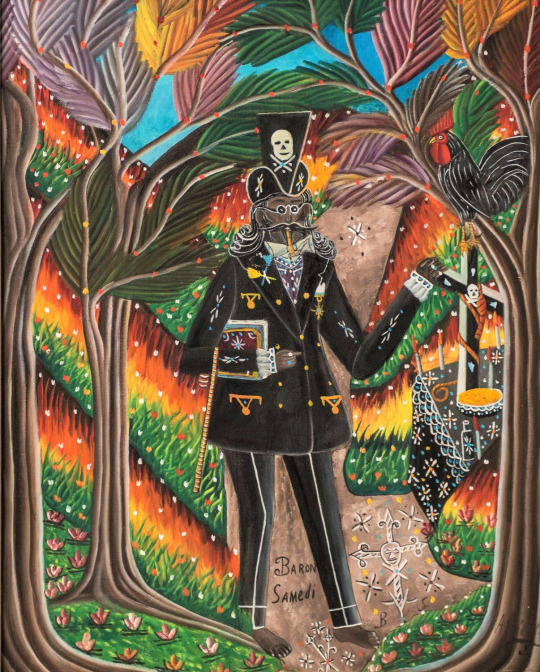
Could be a coincidence, but his glasses and cigar are noteworthy details.
This is also a rare instance where Maman Brigitte’s ethnicity is accurately depicted, although she is younger than traditionally portrayed… Then again, this might be an Angela Bassett situation, where she looks better than college students, but is actually 66 years old.
…Unfortunately, many other renditions are a lot worse than this. What is often passed off as “Baron Samedi” is actually a weird, evil version of Papa Guede, with random African looking shit on him. It’s pretty wack!
This strange, bastardized version of Baron Samedi really is one of the most iconic things about New Orleans Voodoo…or am I wrong to describe him as such?
Is it possible that there is a different version of Baron Samedi worshiped in New Orleans, that is more similar to Papa Guede?
Previously, I had speculated whether Baron Samedi was worshiped in New Orleans prior to the revitalization movement: https://the-girl-who-didnt-smile.tumblr.com/post/760848084922155008/crackpot-theory-baron-samedi-was-worshiped-in-new
If he was, we would expect him to appear similarly to the early descriptions found in the Haitian historical record. “Genealogies of Gede” (2012), Smith & Cosentino comment on these early descriptions like so: “None of the performative or ritual markers we associate today with Gede—the obscene and comic behavior—are present in the text.”
SOURCE: Smith, Katherine, and Donald Cosentino. "Genealogies of Gede." In Extremis: Death and Life in 21st-Century Haitian Art (2012): 84-99.
His physical appearance should also be something like this:
“...Most of the time, however, when going about on the earth, the Negro devil has the appearance of a gentleman, wearing a high silk hat, and a frock coat, and having an "ambrosial curl" in the center of his forehead to hide the single horn which is located there. Mrs. Viriginia Frazer Boyle tells me that when she was first taken to church by her father and mother she used to scan the congregation eagerly for a man with that "ambrosial curl" and one with the "evil eye", which her old Negro nurse had told her were to be found in every crowd, even in church. In most cases this Negro devil has cloven feet, a characteristic also credited to him in European circles. Possibly the black cat is the animal most chosen by the Negro devil for impersonation...Nevertheless the devil is not limited to this particular form but may appear as a rabbit, terrapin, serpent, housefly, grasshopper, toad, bat, or yellow dog at will. To the Mississippi Negroes he often appears as a black billy-goat; a view strictly in keeping with his custom at the English witches' Sabbath. In New Orleans it is thought by some that snakes and black cats are incarnations of the devil…”
Source: Puckett, Newbell Niles. Folk beliefs of the southern Negro. University of North Carolina Press, 1926. https://archive.org/details/folkbeliefsofsou00puck/page/552/mode/2up?q=devil
The physical description does not match how Baron Samedi is portrayed in popular media. As far as I know, it is doubtful that he was a feature of Louisiana Voudou prior to the revitalization movement.
The other possible introduction point would be the revitalization of the late 20th century. Louisiana Voudou of the 19th century either died out or went underground by the early to mid 20th century; it was later ‘revitalized’ in the late 20th century, where one of the major influences was Haitian Vodou. This is why iconography from Haitian Vodou is so heavily associated with the tourist industry of New Orleans, even when there is little evidence these were features of historical Louisiana Voudou.
Recall Courlander’s claim that Baron Samedi is equated with Gede Nibo in some regions of Haiti. If he was correct, it is possible that Haitian(s) from said region(s) introduced this version of Baron Samedi to Americans, who then introduced this to New Orleans.
When reporting his observations in Haiti, Melville Herskovits corresponded with three different sources. He wound up with three different lists of lwa that contradict each other, as previously quoted.
The point is, there are legitimate regional differences in Haiti. Are they called lwa (loa) or jany (zange)? What is the name of the child on Erzulie Dantor’s wrist? Does Erzulie Dantor make people homosexual? Two different credible sources can give you different answers to such questions, including the manner in which certain lwa are classified. This might explain the portrayal of Baron Samedi in New Orleans.
Still, there is a factor of uncertainty here, and concrete evidence is lacking. With this in mind, it is best to adhere to the descriptions provided by Haitians, where Baron Samedi is easily delineated from Papa Guede.
There is another misconception that associates Baron Samedi and (Papa) Gede Nibo with the LGBTI community. This is quite the offensive misrepresentation, which warrants its own essay: https://the-girl-who-didnt-smile.tumblr.com/post/770627900843098112/the-gede-rite-is-not-associated-with-the-lgbti
3 notes
·
View notes